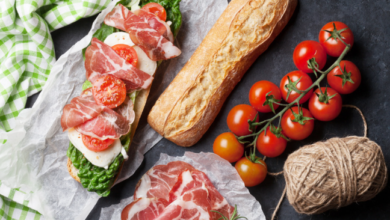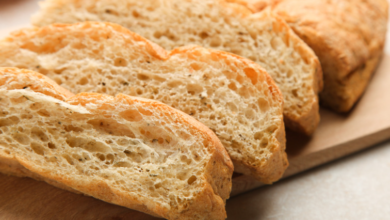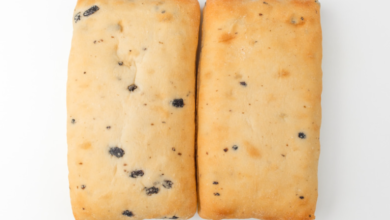What makes ciabatta bread unique? Your answer is here!

What To Know
- The unique combination of ingredients and baking techniques used in its creation resulted in a bread that quickly gained popularity and spread throughout the world.
- Ciabatta is typically baked at a high temperature in a stone oven.
- Ciabatta bread contains a moderate amount of fiber, which can aid in digestion and promote a feeling of fullness.
Ciabatta, an Italian bread known for its airy crumb and crisp crust, has captured the hearts of bread enthusiasts worldwide. Its distinctive characteristics set it apart from other bread varieties, making it a culinary delight. In this article, we delve into the unique qualities of ciabatta bread, exploring what makes it so exceptional.
The Ancient Origins of Ciabatta
Ciabatta, meaning “slipper” in Italian, originated in the Veneto region of Italy in the 1980s. It is believed to be a modern interpretation of traditional Italian breads. The unique combination of ingredients and baking techniques used in its creation resulted in a bread that quickly gained popularity and spread throughout the world.
The Exceptional Crust
One of the most striking features of ciabatta bread is its crisp and crackly crust. This crust is achieved through a combination of factors, including:
- High Hydration: Ciabatta dough has a high water content, which creates steam during baking. This steam helps to form the characteristic blisters and cracks in the crust.
- Long Fermentation: The dough is left to ferment for an extended period, allowing the yeast to produce carbon dioxide. This gas expands during baking, creating the airy crumb and crispy crust.
- Baking Technique: Ciabatta is typically baked at a high temperature in a stone oven. This creates a quick burst of heat that sets the crust and gives it its distinctive texture.
The Airy Crumb
The crumb of ciabatta bread is equally unique, characterized by its large, irregular holes. This airy texture is achieved through:
- High Hydration: The high water content in the dough creates a loose and extensible gluten network. This allows the dough to expand more during baking, resulting in the formation of large holes.
- Long Fermentation: The extended fermentation period allows the yeast to produce more carbon dioxide, which further expands the dough and creates the characteristic airy crumb.
- Shaping Technique: Ciabatta dough is typically shaped into flat loaves with a rough and rustic appearance. This allows for maximum expansion during baking and prevents the holes from collapsing.
The Distinct Flavor
Ciabatta bread has a mild and slightly tangy flavor that complements a wide range of dishes. This flavor is influenced by:
- Natural Ingredients: Ciabatta is typically made with only a few simple ingredients: flour, water, salt, and yeast. The absence of added sugars or fats results in a clean and wholesome flavor.
- Fermentation: The long fermentation period allows for the development of complex flavors, including lactic acid and acetic acid. These acids contribute to the tangy and slightly sour notes in ciabatta.
- Baking Technique: The high temperature baking caramelizes the sugars in the dough, adding a subtle sweetness and depth of flavor.
The Versatile Uses
Ciabatta bread’s unique texture and flavor make it a versatile addition to any meal. It can be enjoyed:
- As a Sandwich Bread: The airy crumb and crisp crust make ciabatta an excellent choice for sandwiches. It provides a sturdy base that can hold up to hearty fillings.
- In Salads: The large holes in ciabatta bread allow it to absorb dressings and flavors from salads. It adds a satisfying crunch and texture to green salads, pasta salads, and bean salads.
- As a Dipping Bread: The crispy crust and mild flavor of ciabatta make it an ideal dipping bread for soups, stews, and sauces.
- In Breadcrumbs: Ciabatta breadcrumbs add a flavorful and crunchy texture to dishes such as meatballs, fish sticks, and casseroles.
- As a Base for Bruschetta: Ciabatta slices are a traditional base for bruschetta, topped with tomatoes, garlic, and olive oil.
The Health Benefits
Ciabatta bread, while not as nutrient-dense as some other whole grain breads, offers certain health benefits:
- Fiber: Ciabatta bread contains a moderate amount of fiber, which can aid in digestion and promote a feeling of fullness.
- Antioxidants: The long fermentation period allows for the development of antioxidants, which can protect against cell damage.
- Low Glycemic Index: Ciabatta bread has a relatively low glycemic index, meaning it does not cause a rapid spike in blood sugar levels.
The Craft of Ciabatta
Creating authentic ciabatta bread requires skill and attention to detail. The process involves:
- Selecting the Right Flour: Ciabatta is typically made with a strong bread flour, which contains a high protein content. This protein forms a strong gluten network that supports the airy crumb.
- Proper Hydration: The high water content in ciabatta dough is crucial for achieving the desired texture. The dough should be sticky and elastic, but not too wet.
- Long Fermentation: The dough is allowed to ferment for an extended period, typically 12-24 hours. This allows the yeast to develop fully and produce the characteristic flavors and textures.
- Gentle Handling: Ciabatta dough is delicate and should be handled gently during shaping and baking. Overworking the dough can result in a dense and chewy bread.
- High Temperature Baking: Ciabatta is baked at a high temperature to create a quick burst of heat that sets the crust and gives it its distinctive texture.
The Future of Ciabatta
Ciabatta bread continues to evolve and inspire culinary creations worldwide. Bakers are experimenting with different flours, fermentation techniques, and flavorings to create unique variations on this classic bread. The future of ciabatta looks bright, as it remains a beloved culinary staple that is sure to delight generations to come.
Popular Questions
1. What is the difference between ciabatta and focaccia bread?
Ciabatta and focaccia are both Italian breads with a similar appearance, but they have distinct characteristics. Ciabatta has a more airy and open crumb, while focaccia has a denser and chewier crumb. Ciabatta is also typically shaped into flat loaves, while focaccia is often made in a round or rectangular shape.
2. How do I store ciabatta bread?
Ciabatta bread can be stored at room temperature for 2-3 days. For longer storage, it can be frozen for up to 3 months. To freeze ciabatta, wrap it tightly in plastic wrap or foil. When ready to serve, thaw the bread at room temperature or reheat it in a warm oven.
3. What is the best way to reheat ciabatta bread?
The best way to reheat ciabatta bread is to place it in a warm oven for 5-10 minutes, or until it is heated through. You can also reheat ciabatta bread in a toaster oven or on a grill.





